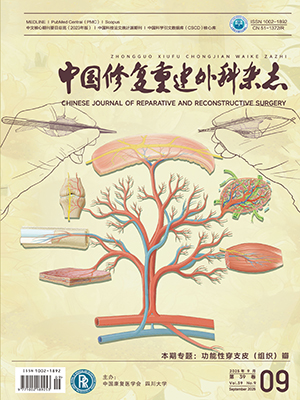Objective To study the curative effects of keloid by operation combined with postoperative β radiation and silicone gel sheeting. Methods From 1996 to 2002, 598 patients with keloid(243 males, 355 females, aging 15-55 years with an average of 28.6 years) were treated by integrated therapy. Their disease courses were from 6 months to 6 years. The keloid area ranged from 1.0 cm×1.5 cm~8.0 cm×15 cm. First, keloid was removed by operation, and then the wounds weresutured directly(group suture) or covered with skin graft(group graft). In groupsuture, the operational sites were managed by β ray radiotherapy 24-48 hours after operation. The total doses of radiation were 12-15 Gy, 5 times 1 week(group suture A) and 10 times 2 weeks (group suture B). Radiotherapy was not taken until stitches were taken out in group graft, and then the same methods were adopted as group suture B. After radiotherapy, silicone gel sheeting was used in 325 cases for 3-6 months. Results All patients were followed up for 12-18 months. (1) The overall efficacy was 91.3% in group suture A(n=196), and 95.8% in group suture B (n=383), respectively. There was significant difference between the two groups(P lt;0.01). (2) Radiotherapy was of no effect in 6 cases of group graft(n=19). (3) Silicone gel sheeting had effectivenessin 185 cases. Silicone gel sheeting had no obvious effect on the overall efficacy, but it could improve the quality of texture and color of skin. Conclusion By use of integrated methods to treat keloid, if the wound can be sutured directly, skin grafting should not be adopted. The results in group suture B are better than those in group suture A; silicone gel sheeting should be used as possible.
Citation: CUI Zhengjun,CEN Ying,LIU Xiaoxue,et al.. ANALYSIS OF CURATIVE RESULT FOR KELOID WITH INTEGRATED METHODS. Chinese Journal of Reparative and Reconstructive Surgery, 2004, 18(2): 156-158. doi: Copy
Copyright © the editorial department of Chinese Journal of Reparative and Reconstructive Surgery of West China Medical Publisher. All rights reserved




